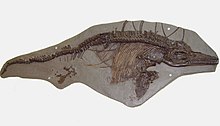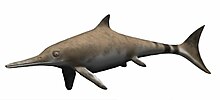Ichthyosaurus
| Ichthyosaurus Temporal range: Early Jurassic,
| |
|---|---|

| |
| Fossil specimen of I. breviceps | |
| Scientific classification | |
| Domain: | Eukaryota |
| Kingdom: | Animalia |
| Phylum: | Chordata |
| Class: | Reptilia |
| Order: | †Ichthyosauria |
| Node: | †Thunnosauria |
| Family: | †Ichthyosauridae De la Beche & Conybeare, 1821 |
| Genus: | †Ichthyosaurus De la Beche & Conybeare, 1821 |
| Type species | |
| †Ichthyosaurus communis Conybeare, 1822
| |
| Species | |
Ichthyosaurus (derived from Greek ιχθυς/ichthys meaning 'fish' and σαυρος/sauros meaning 'lizard') is a genus of ichthyosaurs from the early Jurassic (Hettangian - Sinemurian) of Europe (Belgium, England, Switzerland). It is among the best known ichthyosaur genera, with the Order Ichthyosauria being named after it.[1][2][3] Ichthyosaurus was the first complete fossil to be discovered in the early 19th century by Mary Anning in England.[4]
Biology


Ichthyosaurus were smaller than most of their relatives, with individuals measuring up to 2 metres (6.6 ft) in length. Hundreds of well-preserved, fossilised skeletons have been found in Jurassic rock at Holzmaden, Germany. Some of the bones were still articulated. Some fossils still had baby specimens inside them, indicating that Ichthyosaurus was viviparous. Similar finds in the related Stenopterygius also show this.[5][6] The German fossils also featured the outline of Ichthyosaurus's skin, revealing that it had a fleshy dorsal fin on its back and a large caudal fin. Other ichthyosaur fossils showed this feature was not limited to Ichthyosaurus.

Ichthyosaurus ear bones were solid, probably transferring water vibrations to the inner ear. Still, hunting by sight was the creature's main feeding activity; it had huge, sensitive eyes, protected by bony shields. Coprolites of Ichthyosaurus reveal that its diet consisted of fish and squid.[7]
It was initially believed that Ichthyosaurus laid eggs on land, but fossil evidence shows that in fact the females gave birth to live young. As such, they were well-adapted to life as fully pelagic organisms (i.e. they never came onto land). The babies were born tail first to prevent them from drowning in the water.[5]
References
- ^ Maisch MW, Matzke AT. 2000. The Ichthyosauria. Stuttgarter Beiträge zur Naturkunde Serie B (Geologie und Paläontologie) 298: 1-159
- ^ McGowan C, Motani R. 2003. Ichthyopterygia. – In: Sues, H.-D. (ed.): Handbook of Paleoherpetology, Part 8, Verlag Dr. Friedrich Pfeil, 175 pp., 101 figs., 19 plts; München
- ^ Maisch MW, Reisdorf AG, Schlatter R, Wetzel A. 2008. A large skull of Ichthyosaurus (Reptilia: Ichthyosauria) from the Lower Sinemurian (Lower Jurassic) of Frick (NW Switzerland). Swiss Journal of Geosciences 101: 617-627.
- ^ Essesials of Anthropology 6th addition
- ^ a b Böttcher R. 1990. Neue Erkenntnisse über die Fortpflanzungsbiologie der Ichthyosaurier. Stuttgarter Beiträge zur Naturkunde Serie B (Geologie und Paläontologie) 164: 1-51
- ^ Martill D.M. 1993. Soupy Substrates: A Medium for the Exceptional Preservation of Ichthyosaurs of the Posidonia Shale (Lower Jurassic) of Germany. Kaupia - Darmstädter Beiträge zur Naturgeschichte 2: 77-97
- ^ Palmer, D., ed. (1999). The Marshall Illustrated Encyclopedia of Dinosaurs and Prehistoric Animals. London: Marshall Editions. p. 80. ISBN 1-84028-152-9.
